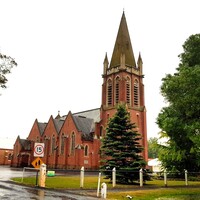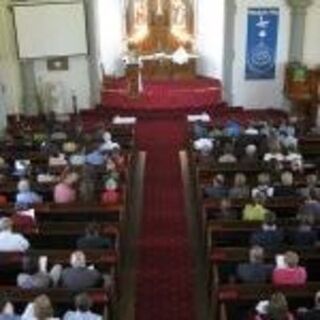We found some more Lutheran churches near Tarrington
Who we are
Tarrington St Michaels Lutheran Church - where love comes to life
We're part of a bigger church family, the Lutheran Church of Australia. Together we want to be a place where love comes to life. We believe that God's love is for everyone, everywhere, and we want you to see how his love comes to life in us – and in you.
We're part of a bigger church family, the Lutheran Church of Australia. Together we want to be a place where love comes to life. We believe that God's love is for everyone, everywhere, and we want you to see how his love comes to life in us – and in you.
Church Address

7887-7901 Hamilton Hwy
Tarrington,
VIC
3301
Australia
Phone: (03) 5572 3840
Fax: (03) 5571 9027
Download St Michael's Lutheran Church Tarrington vCard with Service Times
Click here to contact the church
Denomination
Lutheran Church
Lutheran Churches in Tarrington, VIC
Lutheran Churches in Victoria
Lutheran Churches in Australia
Lutheran Churches near me
All churches in Tarrington, VIC

Affiliations
Lutheran Church of Australia
Church Website
St Michael's Lutheran Church Tarrington on Social Media
Leadership
Leader Name:
Leader Position:
Formal Title:
Leader Address:
Phone:
Fax:
(03) 5571 9027
Leader Email:
Click here to contact the church
Leader Bio:
on Social Media:
Other Church Leaders:
Leadership Photos
Add a Photo
Administration
Admin Name:
Matthew Linke
Admin Position:
Treasurer
Admin Address:
Phone:
Fax:
(03) 5571 9027
Admin Email:
Click here to contact Matthew Linke
Mailing Address
PO Box 60
Tarrington, Vic
3301
Tarrington, Vic
3301
Driving Directions
Travel/Direction Tips
Know how to get there? Share the knowledge with others!
Parking
Ample on-site parking
St Michael's Lutheran Church Tarrington Service Times
Sunday 9:00 AM
It's been more than a year since the last service times update. Please make sure to contact the church to confirm service times.
Please contact the church to confirm Service Times or SUBSCRIBE to updates below
It's been more than a year since the last service times update. Please make sure to contact the church to confirm service times.
Please contact the church to confirm Service Times or SUBSCRIBE to updates below
Worship Languages
Dress Code
Sunday School / Children and Youth Activities
Under 12s:
Under 18s:
Local outreach & community activities
Other activities & ministries
Special Needs/Accessibility
Prayers and Hymns
Main Bible:
Hymns and Songs:
Other information
Average Adult Congregation:
Average Youth Congregation:
Additional Info:
St Michael's Lutheran Church Church Tarrington Photos
St Michael's Lutheran Church Tarrington History
Pastor C W Schurmann arrived in the Hamilton district in 1854 and an Evangelical Lutheran congregation was established at "South" Hamilton, about a mile east of the township. The first building was a pug and timber framed church with a thatched roof. This would have been similar to the first residences built by Lutherans, some of which still survive. Michael Deutscher had purchased the land, allotment 3 of section 1 of the Parish of South Hamilton comprising some 81 acres, in 1854 and ten acres was subdivided from it for the purpose. In 1855 Oscar Muller was called to become the first teacher using the primitive church, built a year before, as a classroom. More land in the Parishes of Yatmerone and Boram Boram, closer to Penshurst, was made available for purchase and many recently arrived Lutheran settlers bought blocks there. This became the district of Gnardenthal, which Pastor Schurmann would visit on a regular basis, and which was to become the congregation at Tabor. The first services were held in the homes of Andreas Urban and Johann Burger at Gnadenthal.
The first primitive church was replaced by a more substantial building in 1858. It was very simple and Gothic in style. "For more than fifty years this building served as a church and school" (Tarrington Centenary). A bluestone parsonage was built beside it soon afterwards. Completed in 1859 as a house of six rooms, it was added to later with a weatherboard section. Both the first churches and the original manse have been demolished.
The first stone church soon became inadequate for the flourishing congregation and a new bluestone church was built in 1863. It too was in the Gothic style, was four bays long and was surmounted by a timber belfry.
Old photographs show that it had two different porches, one with a perpendicular gable and the other with a larger transverse gable, which was probably the later version. A gallery was added later to accommodate even more members of the congregation. This church was burnt in the disastrous 1944 bush fire, which destroyed much of Tarrington. Stone from its ruins were used to build a memorial in 1983 to mark its 120th anniversary and the 130th anniversary of the complex. By 1865 Hoehkirk was described officially as "a German settlement, and postal village" and that "there are no hotels in the village, arid the population of the district is about 1000 persons, who are engaged in cultivating the fine country on which they are settled" (Bailliere's, 184). The present red brick church was built in 1927 and replaced the earlier stone church. The manse was also replaced during the Interwar period with a large red brick bungalow.
The school has also passed through many stages. One of the more interesting structures is a purpose built classroom built in 1913. It uses pressed cement blocks for the construction of the walls. The same technique is used in several other buildings in and around Tarrington about the same time. Other wise the classroom is conventional in its planning and provision of light, for example, by large windows facing south.
Another creambrick wing, incorporating offices, classrooms and other facilities was built in front after the Second World War. Built in the Modeme or International style, it is unusual for its curved plan and split skillion roof. This has been altered recently by the addition of a porch linking it to the adjacent brick hall.
As with the three other Lutheran schools at Tabor, Warrayure and Lake Linlithgow the teaching of German language, history and culture during the First World War provoked antagonism and prejudice amongst the general population. There were calls to close the schools but an examination by an Education Department Inspector in 1916 found no disloyalty (Garden, 191). The campaign against the schools continued for some time after the end of the war. Under pressure from the state government and the local council, Hochkirk changed its name to Tanington. This was based on the name of the house of Stephen Henty, some distance to the south of the town, which itself was named after the town in England where the Henty family had come from.
Lutherans in south-eastern Australia in the nineteenth and twentieth centuries were seriously divided by doctrinal differences (Phillips in Lewis, 14-5). The personality of leaders seems to have influenced allegiances as well. There was a schism in 1846. The congregations in the Hamilton district continued to look to the Evangelical Lutheran Synod of South Australian led by Pastor Fritzsche Lobethal. Pastor Schtumann had died at Bethany in the Barossa Valley attending a Synod in 1893. The other Lutherans in Victoria were further divided but came together as the General Synod of 1876 only to split in 1884. The Lutheran Church Federation was formed in 1920 but still did not include the Hamilton congregations. It was not until 1966 that the two streams came together as the Lutheran Church of Australia.
The St Michael's congregation must be seen in association not only with the original Evangelical Lutheran congregation at South Hamilton and the Tabor, Gnadenthal, Purdeet and Lake Linlithgow districts but also the congregations at Warrayure, Byaduk. These relationships were always cordial and supportive. In the early twentieth century there was a direct connection with Lutherans who had migrated even further north into the new wheat belt of the Wimmera.
More difficult was the relationship with the utopian settlement nearby at Herrrihut established on a mixture of Moravian and communist principles by Friedrich Johann Krurmiow in the mid-1850s. Their differences were not just philosophical and doctrinal hut i1sn Schurmantgs-gyes,the-immeral M i e n s of Krumnow and his communards defiled the good name of all the other Germans in the area" (Metcalf and Huf, 36-7). Most importantly, the 'prophetess', Maria Heller who had spent some time at Hermhut, went across to the Tabor congregation, although eventually expelled from the Lutheran church (Metcalf and Huf, 82). Others also crossed over sapping the settlement of its younger members (Metcalf and Huf, 117).
The St Michael's congregation and school were also sapped by the emigration of many families to the Wimmem when land there was opened up for selection in the 1870s. However, family relationships continued over the decades and were important for both those who stayed and those who went. Children were sent from the Wimmera to school at Tarrington and at Tabor, boarding with their immediate families. The school now accommodates all the Lutheran students of the district following the rationalisation of the schools at Tabor and Warrayure and their consolidation with St Michael's. It now has about 85 students enrolled. The community of Tarrington and the congregation of St Michael's successfully celebrated their 150th anniversary in October 2003 which was recognised by the Southern Grampians Shire as the Community Event of the Year.
The first stone church soon became inadequate for the flourishing congregation and a new bluestone church was built in 1863. It too was in the Gothic style, was four bays long and was surmounted by a timber belfry.
Old photographs show that it had two different porches, one with a perpendicular gable and the other with a larger transverse gable, which was probably the later version. A gallery was added later to accommodate even more members of the congregation. This church was burnt in the disastrous 1944 bush fire, which destroyed much of Tarrington. Stone from its ruins were used to build a memorial in 1983 to mark its 120th anniversary and the 130th anniversary of the complex. By 1865 Hoehkirk was described officially as "a German settlement, and postal village" and that "there are no hotels in the village, arid the population of the district is about 1000 persons, who are engaged in cultivating the fine country on which they are settled" (Bailliere's, 184). The present red brick church was built in 1927 and replaced the earlier stone church. The manse was also replaced during the Interwar period with a large red brick bungalow.
Another creambrick wing, incorporating offices, classrooms and other facilities was built in front after the Second World War. Built in the Modeme or International style, it is unusual for its curved plan and split skillion roof. This has been altered recently by the addition of a porch linking it to the adjacent brick hall.
As with the three other Lutheran schools at Tabor, Warrayure and Lake Linlithgow the teaching of German language, history and culture during the First World War provoked antagonism and prejudice amongst the general population. There were calls to close the schools but an examination by an Education Department Inspector in 1916 found no disloyalty (Garden, 191). The campaign against the schools continued for some time after the end of the war. Under pressure from the state government and the local council, Hochkirk changed its name to Tanington. This was based on the name of the house of Stephen Henty, some distance to the south of the town, which itself was named after the town in England where the Henty family had come from.
The St Michael's congregation must be seen in association not only with the original Evangelical Lutheran congregation at South Hamilton and the Tabor, Gnadenthal, Purdeet and Lake Linlithgow districts but also the congregations at Warrayure, Byaduk. These relationships were always cordial and supportive. In the early twentieth century there was a direct connection with Lutherans who had migrated even further north into the new wheat belt of the Wimmera.
The St Michael's congregation and school were also sapped by the emigration of many families to the Wimmem when land there was opened up for selection in the 1870s. However, family relationships continued over the decades and were important for both those who stayed and those who went. Children were sent from the Wimmera to school at Tarrington and at Tabor, boarding with their immediate families. The school now accommodates all the Lutheran students of the district following the rationalisation of the schools at Tabor and Warrayure and their consolidation with St Michael's. It now has about 85 students enrolled. The community of Tarrington and the congregation of St Michael's successfully celebrated their 150th anniversary in October 2003 which was recognised by the Southern Grampians Shire as the Community Event of the Year.
St Michael's Lutheran Church Tarrington Historical Photos
Add a historical photo
This page is published by JoinMyChurch.com and is managed by St Michael's Lutheran Church Tarrington located at
7887-7901 Hamilton Hwy, Tarrington, VIC
JoinMyChurch.com can be contacted at admin@joinmychurch.com
JoinMyChurch.com can be contacted at admin@joinmychurch.com











